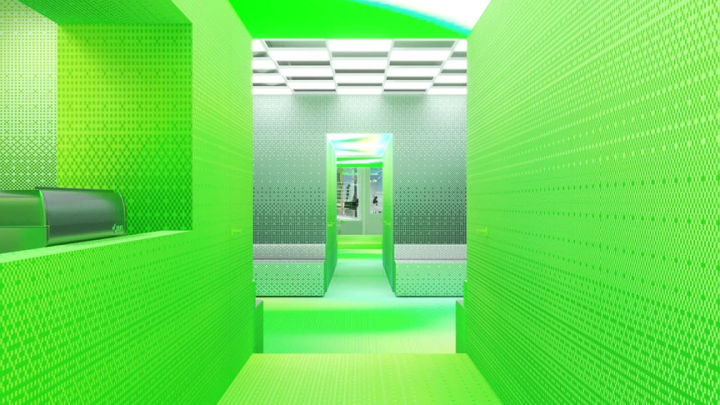Leading augmented reality (AR) platform Zero10 has collaborated with New York-based creative practice Crosby Studios to create a physical pop-up store offering digital fashion and immersive experiences. The concept space, described as a “physical gateway into the metaverse”, has been designed for people to virtually try-on digital fashion via AR, using their smartphones. With the rise of digital fashion and the metaverse, Zero10 believes ‘the future of fashion is hybrid, where physic
sical and digital goods are blended into one united experience’. Crosby Studios has brought this vision to life by creating a space that looks like something out of a ’90s video game. Crosby’s signature pixelated print is featured throughout the space as wallpaper graphics and upholstery patterns, as well as in one of the digital fashion pieces – ‘disappearing pants’.
The pop-up is open 7-18 September in New York and people are urged to book a timeslot to visit, as access is limited. People visiting will have 30 minutes to walk around and virtually try-on digital fashion from the five-piece collection. The range includes Pixel leopard hoodie, Light shirt, Video game pants, Checkers suit, and disappearing pants, which is the first non-fungible token (NFT) by Crosby Studios and will be available for sale via the Zero10 page on NFT marketplace Rarible.
As people explore the space, they’ll be able to try-on digital pieces by scanning a QR code using an iPhone and browsing the collection via the Zero10 app. For anyone who doesn’t have an iPhone, there will be several available in-store to use. The digital fashion collection can be experienced in two ways: live via AR or by uploading a full-body picture so that items can be overlaid onto the image, which can be shared on social media.
In recent years, the focus has been on creating digital fashion for virtual environments, such as games and 3D spaces, as the technology for accurate body tracking in AR has needed significant improvement. Snapchat was one of the first social platforms to enhance its AR capability to handle clothing and accessories. After it released these updates in early 2021, Farfetch and Prada were the first to adopt and offer virtual try-on for a small number of products to their Snapchat audience.
Now, Zero10 has created an AR platform specifically for fashion by developing proprietary technology, without relying on social media platforms and their built-in AR technology. This allows fashion retailers to define a deeper immersive strategy outside social media, to enhance the customer experience and create new channels for engagement within virtual spaces.
Digital-first retailers
Whether it’s for a bricks-and-mortar retailer, an e-commerce brand or both, new and immersive technologies enable retailers to become digital-first. A truly multichannel approach can allow seamless integration and change depending on upcoming ranges, seasonal campaigns, special events, target audiences, and trends.
For bricks-and-mortar retailers, AR leverages the physical environment where they already have a brand presence. This provides an entirely new layer of storytelling through immersive experiences with which customers can interact. This method is increasingly being used to connect with a digital-native audience.
Many retailers are using immersive technologies to create a presence in physical spaces – a unique way of bringing an online brand into the built environment. Zero10 and Crosby Studios created their concept retail space to optimise interactivity, intentionally leaving out physical objects, a point of sale station and inefficient processes that can inhibit the fashion retail experience.
Extending our realities
Digital fashion is not mainstream, but it’s not far off. We won’t suddenly stop buying physical clothing, rather, we’ll obtain digital twins of clothes we buy as well as collect unique digital fashion items that reflect our personality, interests, and beliefs. This new type of intangible fashion opens up a whole other world of self-expression for use in extended realities.
Fashion and beauty are two sectors that have started experimenting with immersive technologies. But AR can be applied to many other retail categories, such as furniture, appliances, interior and exterior paint, and art, to name a few. Our smartphone cameras are able to detect a space and accurately portray items in the space to scale. Showing the user what it would look like before making a purchase.
AR can also be used to provide in-depth product information while customers are shopping. This is an effective way of incorporating smartphones during the consideration phase, as customers are likely to have their phone close if not already in their hands.
As these worlds collide, digital and physical experiences are equally important. Taking a holistic approach and factoring both in at critical touch points will create richer and more memorable interactions with shoppers.
The technology powering AR and the devices required to bring it to life is constantly evolving. Integrated extended-reality channels will soon be a regular part of the shopping journey. Nowhere more so than in fashion, with virtual-try on, special branded experiences to unlock, gamification, and storytelling.







